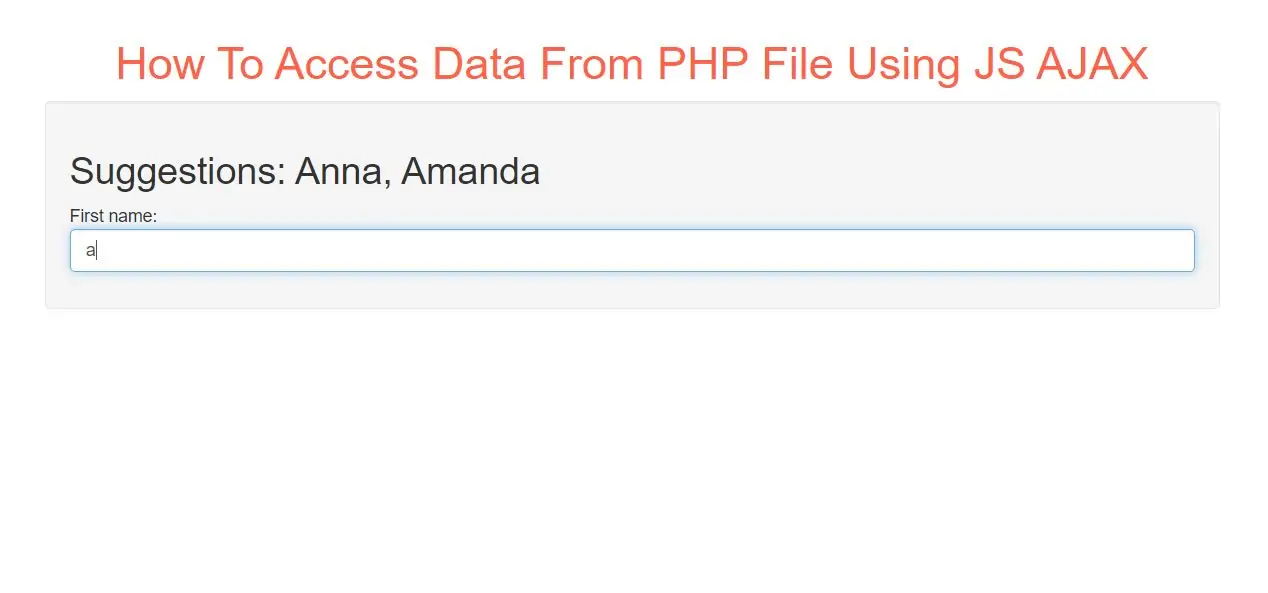
Step 1:
Create index.html and implement below code.
<h2>Suggestions: <span id="demo"></span></h2> <p>First name: <input class="form-control" type="text" id="txt1" onkeyup="showHint(this.value)"></p>
<?php
// Array with names
$a[] = "Anna";
$a[] = "Brittany";
$a[] = "Cinderella";
$a[] = "Diana";
$a[] = "Eva";
$a[] = "Fiona";
$a[] = "Gunda";
$a[] = "Hege";
$a[] = "Inga";
$a[] = "Johanna";
$a[] = "Kitty";
$a[] = "Linda";
$a[] = "Nina";
$a[] = "Ophelia";
$a[] = "Petunia";
$a[] = "Amanda";
$a[] = "Raquel";
$a[] = "Cindy";
$a[] = "Doris";
$a[] = "Eve";
$a[] = "Evita";
$a[] = "Sunniva";
$a[] = "Tove";
$a[] = "Unni";
$a[] = "Violet";
$a[] = "Liza";
$a[] = "Elizabeth";
$a[] = "Ellen";
$a[] = "Wenche";
$a[] = "Vicky";
// get the q parameter from URL
$q = $_REQUEST["q"];
$hint = "";
// lookup all hints from array if $q is different from ""
if ($q !== "") {
$q = strtolower($q);
$len=strlen($q);
foreach($a as $name) {
if (stristr($q, substr($name, 0, $len))) {
if ($hint === "") {
$hint = $name;
} else {
$hint .= ", $name";
}
}
}
}
// Output "no suggestion" if no hint was found or output correct values
echo $hint === "" ? "no suggestion" : $hint;
?>
Step 3:
Now Implement java script to access php file data.
<script>
function showHint(str) {
var xhttp;
if (str.length == 0) {
document.getElementById("txtHint").innerHTML = "";
return;
}
xhttp = new XMLHttpRequest();
xhttp.onreadystatechange = function() {
if (this.readyState == 4 && this.status == 200) {
document.getElementById("demo").innerHTML = this.responseText;
}
};
xhttp.open("GET", "getdata.php?q="+str, true);
xhttp.send();
}
</script>
Code explanation:
First, check if the input field is empty (str.length == 0). If it is, clear the content of the txtHint placeholder and exit the function.
However, if the input field is not empty, do the following:
Complete Code For Accessing Data From PHP Files Using JS AJAX
<!DOCTYPE html>
<html>
<head>
<title>How To Access Data From PHP File Using JS AJAX</title>
<meta charset="utf-8">
<meta name="viewport" content="width=device-width, initial-scale=1">
<link rel="stylesheet" href="https://maxcdn.bootstrapcdn.com/bootstrap/3.4.1/css/bootstrap.min.css">
</head>
<body>
<div class="container">
<br>
<div class="text-center">
<h1 id="color" style="color: tomato">How To Access Data From PHP File Using JS AJAX</h1>
</div>
<div class="well">
<h2>Suggestions: <span id="demo"></span></h2>
<p>First name: <input class="form-control" type="text" id="txt1" onkeyup="showHint(this.value)"></p>
<script>
function showHint(str) {
var xhttp;
if (str.length == 0) {
document.getElementById("txtHint").innerHTML = "";
return;
}
xhttp = new XMLHttpRequest();
xhttp.onreadystatechange = function() {
if (this.readyState == 4 && this.status == 200) {
document.getElementById("demo").innerHTML = this.responseText;
}
};
xhttp.open("GET", "getdata.php?q="+str, true);
xhttp.send();
}
</script>
</div>
</div>
</body>
</html>